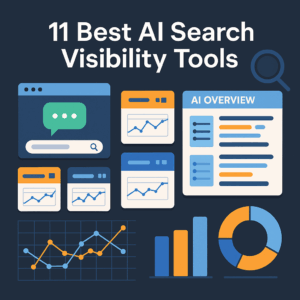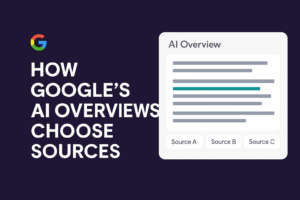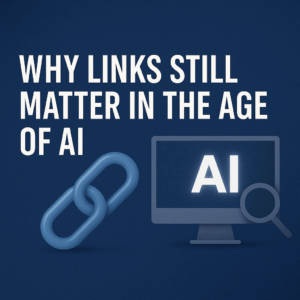Do you know 70% of consumers believe in whatever is shown by generative AI search results? Not only this, but also since March 2025, these generative AI Overviews have grown by 115%. To make up in the Google SERPs is no longer the sole goal of posting content; rather, appearing in both Google and AI-based models, recently emerging LLMs, is becoming equally important as well. Therefore, today, we will look into SEO for LLMs, what that is, how LLMs affect search results, tips for optimization, and pitfalls to avoid.
What is LLM SEO
LLM SEO refers to the structuring of the information for making AI language models grasp it.
The goal is for LLMs to find data, understand it well, include your content in the responses provided to user queries, and refer your brand or site whenever possible.
LLM SEO goes beyond link-building. It focuses more on context, data availability, trustworthiness, and consistency. Ensuring you follow the procedures that let these models use your content as a reliable source is the key to keep appearing in the model searches.
How LLM Affects Search Results
With search engines evolving and AI getting widely adopted. Chatbots like Gemini, Claude, ChatGPT, DeepSeek, etc., are changing the dynamics and reducing the dominance of Google. Users are no longer searching with exact keywords and short sentences. Rather, there is a shift that involves users explaining their specific query in ultimate detail using prompts.
For example, earlier, users used to search for terms like “best cafe in Amsterdam”. Instead, now these users are searching for “What’s the best hidden cafe in Amsterdam that’s open till late hours?”
Moreover, these users are not looking for 10 sources to find out the answers; rather, they want a straightforward value-adding answer in one go, making content structure and context play a greater role.
LLMs don’t rank websites like Google used to. Instead, they analyse, summarize, and synthesize information from various sources to create a well-appreciated answer. Hence, when your content is organized, detailed, and backed by relevant data, it is more likely to be used as a part of the answer framed by these AI models.
Traditional Vs LLM SEO
| SEO Element | Traditional SEO | LLM SEO |
| Keyword Strategy | Emphasis on keyword volume, density, and intent-based targeting. | Shifting focus on semantic relevance and contextual clarity. |
| Content Structure | Frequent content updates. Use heading structure and alt text for crawling. | Real-time models rely on recent and high-trust sources. |
| Linking | Internal and external placement. | Trusted citation, consistent NAP info, and cross-channel brand mentions. |
| Ranking | Optimize for SERP position using domain authority and link-building. | Optimized for LLM-generated responses. |
Optimizing LLM Best Practices
- Use Original Data
LLMs prefer content that includes original and credible data. Publishing statistics, such as surveys, benchmarks, and user data, allows your brand to earn high-authority backlinks.
Tips to create & publish original data:
- Include clean tables
- Brief methodology notes
- Conduct quick surveys
- Focus on structuring
- Add details like sample size, source, and data, etc.
For example, B2B SaaS companies reduce churn by 39%.
- Opt for a Conversational Tone
Keep the tone user-friendly. Avoid overloading your content with related symptoms, awkward keyword usage, and AI-generated, non-edited, low-quality content. LLMs recognize the flow, tone, and authenticity of the content. The write-up is less likely to be favoured.
Aim for the tone that accelerates real conversations. Explain things clearly, causally, and in a human-sounding way as if you are explaining the concepts to your colleagues.
- Build Trust with Google’s Knowledge Graph
Modern LLMs such as Gemini, Claude, GPT-4, etc. pull data from trusted public knowledge bases. Google’s Knowledge Graph, Wikipedia, and other structured data sources are used to validate and contextualize entities. This knowledge graph aggregates structured, verified data about people, concepts, and organizations.
How to get into this knowledge graph:
- NAP Consistency
Check name, address, and phone are correct across various citation sources. Whitespark is the best tool to use for auditing and updating.
- Use Schema Markup Strategically
LLMs do not directly read schema, but the knowledge graph does, and schema strengthens an entity’s association. Focus on key types like Organization, Person, SameAs, etc.
- GBP
Optimizing Google Business Profile helps in better listing, including categories, reviews, images, descriptions, etc.
- Submit Using Knowledge Panel Feedback
Google’s Search Console feedback form allows you to suggest corrections and claim ownership.
- Use Entities
An entity can be anything: a place, an object, a person, or a concept, anything that search engines and LLMs use to understand and recognize things. These entities are context-relevant and allow the algorithm to understand the intent behind every query. The entity optimization involves strategically aligning the brand name with related terms across multiple digital channels to make it easily detectable, processable, and linkable by LLMs.
The main goal here is to refer to entities in the most clear and descriptive manner using company name, key personnel, location, products/services, tags, etc. Experts in this field can use tools like Google’s Natural Language API for assistance in entity recognition, extraction, and sentiment analysis. Also, there is this tool which even beginners can use, Surfer’s Content Editor, to simplify the process by conducting relevant research related to the topic and predicting ideal usage patterns.
This optimization helps in strengthening the entity’s visibility and avoiding confusion in how LLMs generally associate your brand with topics. Further, use BrightLocal’s Citation Tracker to identify and correct inconsistencies in NAP (Name, Address, Phone) across various platforms.
Furthermore, LLMs often rely on Retrieval Augmented Generation (RAG) to pull out relevant content rather than emphasizing schema markups anymore.
For example, when someone asks models like GPT to suggest remote work-friendly laptops, models like MacBook, Lenovo, and HP Pavilion pop up, but it will not show you PCs with complicated setups or 16-inch Laptops with gaming features. How does GPT learn which one to recommend?
Based on various articles, videos, and discussion forums, these chatbots source the data and make recommendations leveraging the entire web.
- Answer User Queries
LLMs introduce search behaviour by preferring natural language and question-based queries for digging into the queries that users type directly into AI searches and voice assistants. Where Traditional SEO prioritises terms like “blockchain definition”, LLM optimization focuses more on “What is blockchain?”
Create an actionable content strategy for LLM optimization using these:
- Target full, natural-language questions users are likely to ask.
- Focus on clear & direct human-written answers.
- Avoid overstepping keywords.
Expert tip: Structure your content clearly, providing concise, helpful answers that easily refer to and repurpose content.
- Follow the Topic Clustering Approach
Rather than publishing isolated blog posts, structure your content plan according, develop supportive content, and explore multiple perspectives. LLMs and search engines favour well-connected branches to each other with interlinking.
For example, at InspiringLads, we helped a B2B SaaS client focus on the topic of predictive maintenance, creating a series of 10 interconnected topics. Within weeks, ChatGPT-4 began suggesting its content as a trusted source. The organic traffic grew by 28% within 3 months.
- Traditional SEO + Digital PR
SEO remains foundational with the rise of AI. The majority of LLM models are trained on public data originating from web-optimized websites. When content organically ranks, it is likely to be part of training data using real-time sources. Maximize your visibility in search engines and LLMs with the following tips:
- Topical depth
Create content that answers your users’ queries in detail and with clarity.
- Internal linking
Clean and quality internal links help LLMs in understanding the context across the pages.
- Keyword research
Include long-tail keywords and focus on semantic searches.
- Backlinking profile
Build trust signals for both search engines’ algorithms and AI models.
Mistakes to Avoid
Overstuffing keywords and AI-targeted repetition
Structuring content using headings unnaturally and duplicating the same phrases with retargeting can degrade the reader’s experience.
Understand the infrastructure
Understanding the infrastructure behind AI while building your model requires significant computational resources and budget. Here, most of the teams focus on producing structured and reliable information.
Utilize accurate technical references
Discussing model training data, cite the correct scale, such as LLaMA 2, to be sure to use accurate figures. For example, the 2 trillion tokens noted in Touvron et al. (2023). Updated data strengthens the credibility, addressing the technical audiences.
Keep content updated
Many LLMs are trained on static data with defined cutoffs, calling out the timeliness of your statistics, helping position your content as a reliable and current source.
Track and Measure Using Surfer’s AI Tracking Tool
LLMs influence search behaviour. To track and mention, use tools like GA4. This is how to use it:
- Create a new Black Exploration
- Add dimensions & metrics
- Build a custom segment and regex pattern to filter traffic
They now act as referral engines similar to search engines. Attribution helps you understand how AI tools influence brand discovery.
Wrapping Up
Optimizing content is not enough anymore. To appear in various LLMs as well as to stay important for Google, creating content that is authentic, value-adding, well-cited, and structured is also crucial.
Moreover, LLM SEO is not a replacement for traditional SEO rather an add-on to make your content more realistic and trustworthy. It blends technical structure, enhances clarity, improves consistency, and provides new standards of visibility for creating content and optimizing websites.
The bottom line is that there is a need to treat LLM optimization and traditional SEO as one while building trust across the web. Answer real questions, add original data, and create content with an authoritative voice to stand out in a competitive environment.




